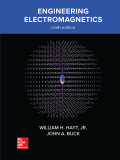
Concept explainers
A short dipole-carrying current I0 cos
(a)
A unit vector of electric field that shows the instantaneous direction of E for a short dipole.
Answer to Problem 14.1P
A unit vector of electric field that shows the instantaneous direction of E for a short dipole is
Explanation of Solution
Given:
k =1 rad/m
r = 2 m
Concept Used:
In spherical co-ordinate component of electric field is given by,
Calculation:
Plugging r =2 in above equations
Therefore,
Vector
Normalize above vector by dividing their magnitude.
Converting above equation in real instantaneous form.
Hence,
at t =0
Conclusion:
Therefore, the unit vector of electric field that shows the instantaneous direction of E for a short dipole is
(b)
The fraction of total average power is radiated in the belt
Answer to Problem 14.1P
The fraction of total average power is radiated in the given belt is 0.258.
Explanation of Solution
Given:
Concept Used:
Calculation:
Integrate above equation over the belt.
Evaluating above integral.
While total power is found by performing the same integral over
Therefore, the fraction of the total power is,
Conclusion:
Hence, the fraction of total power radiated to the given belt is 0.258.
Want to see more full solutions like this?
Chapter 14 Solutions
Engineering Electromagnetics
- A 100-kVA, 2500/125-V, 50-Hz, step-down transformer has the following parameters: R1= 1.5Ω, X1= 2.8Ω, R2= 15mΩ, X2=20mΩ, Rc1= 3kΩ, Xm1= 5kΩ The transformer delivers 85% of the rated load at a terminal voltage of 115 V and a power factor of 0.866 lagging. Determine (a) the efficiency, and (b) the voltage regulation. Draw the phasor diagram of the transformer. Use the approximate equivalent circuit referred to the secondary side.arrow_forwardDon't use ai to answer I will report you answerarrow_forwardDon't use ai to answer I will report you answer.arrow_forward
- PV station 8.6 Consider the microgrid given in Figure 8.56. The positive sequence impedance of the transmission lines is given in the one-line diagram (Figure 8.56). The system data are as follows: PV generating station: 2 MW, 460 V AC; positive, negative, and zero sequence impedance of each line is equal to 10%. The gas turbine gen- erating station is rated at 10 MVA, 3.2 kV, with positive sequence reac- tance of 10%. The generator negative sequence impedance is equal to the positive sequence, and the zero sequence impedance is equal to half (1/2) of the positive sequence impedance. Transformers' positive sequence impedance is equal to the negative sequence and equal to the zero sequence impedance. DC/AC 3 CB T₁ AC PV bus YA 6 1+/10 20 CB CB CB m 0.5+15 личи 5 A S5 2 Gas turbine 0.3+16 7 ww NA Local S6 ST utility Figure 8.56 A one-line diagram for Problem 8.6.arrow_forwardCan you calculate the needed values. When it ask me to measure the values do I attach the function generator and use the values mentioned below? or do i leave the function generator off and measure? Any tips on how to connect the multimeters would be appreciated but not primary request.arrow_forwardDon't use ai to answer I will report you answerarrow_forward
- Don't use ai to answer I will report you answerarrow_forwardYou are tasked with designing an electronic system for sensing the magnitude of a measurand (details and values to be provided on the day of the exam). The system must alert a user to a measurand value above a threshold, measured by an appropriate sensor, by turning on a buzzer (to make a sound). The buzzer must remain off below this threshold. All resistors used must be from the E12 series. This work is to be performed on TinkerCAD. To fully answer the question, you must provide: • Full calculations for all components you use, clearly indicated what you are calculating. • A screenshot of the TinkerCAD circuit with it in the buzzer off state (clearly showing the full circuit including the sensor). • A screenshot of the TinkerCAD circuit with it in the buzzer on state (clearly showing the full circuit including the sensor). • A written explanation of how the circuit works and justification of your design (approx. 200 words).arrow_forwardcan I have a written solutionarrow_forward
- Q1 Q2 A control system is described by the block diagram in Figure 1 where R(s) is reference input and Y(s) is system output. (a) Find the transfer function Y(s)/R(s) using block diagram reduction. (b) Determine the steady state output in response to the unit step input. R(s) + + S 5 -~ $2 1 Y(s) 2s s² +2 Figure 1 A PID controller is designed to control the robot leg, and the control system is shown in Figure 2 where K is a positive gain. (a) Find the closed-loop transfer function (s)/R(s). (b) Use the Routh-Hurwitz stability criterion to determine the range of the parameter K such that the closed-loop system is stable. (s) 2 K 1+-+s s² + 3s+2 S R(s) PID Controller Robot Leg dynamics Figure 2arrow_forwardQ3 (a) For the digital control system given in Figure 3, by adding phantom samplers to show that the z transfer function of the closed-loop system is given by C(z) R(z) G(z) 1+ G(z) H₁H₂(z) + R(s) G(s) C(s) H₂(s) H₁(s) Figure 3 (b) The analogue compensator 5s + 1 D(s) = 0.4s +1 is implemented digitally with sampling period 0.2 seconds to control the depth of a submarine system. Use the pole-zero mapping method to find a digital approximation to the analogue compensator.arrow_forwardConsider an RC circuit with a 5 ohm resistor, a 0.05 faraday capacitor, and a constant 60 V battery. If the initial charge on the capacitor is zero, i.e. q(0) = 0 determines the charge on the capacitor at any time q(t).Strictly not using chatgpt or AI need proper explaination by handarrow_forward
 Delmar's Standard Textbook Of ElectricityElectrical EngineeringISBN:9781337900348Author:Stephen L. HermanPublisher:Cengage Learning
Delmar's Standard Textbook Of ElectricityElectrical EngineeringISBN:9781337900348Author:Stephen L. HermanPublisher:Cengage Learning
